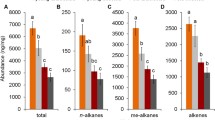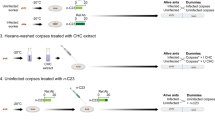Abstract
Host entry is a crucial step in a parasite’s life cycle. When parasites manage to circumvent host detection, exploitation of host resources is facilitated, as host defenses have not to be counteracted. Social parasites exploit animal societies and, likewise, detection avoidance can be beneficial. Yet, due to strong selection pressures, hosts of socially parasitic slavemaking ants often recognize them as enemies, so that slavemakers use open force to raid host colonies. These fights, however, prohibit the enslavement of adult host workers (eudulosis), which cannot be manipulated to work for them. Instead, they steal brood during raids, and enslave those upon emergence. In contrast to the violent raids of most slavemakers, no aggression occurs during most of the raids of the newly described slavemaker Temnothorax pilagens. Thereby, T. pilagens regularly induces adult host workers to be part of their slave workforce. We demonstrate that non-enslaved colonies of its host species respond to this slavemaker with little aggression. We further investigate how the slavemaker circumvents recognition and show that chemical resemblance of host profiles might explain the low aggressive responses. But, which parameters determine whether slave raids escalate, resulting in carnage among defenders? Our experiments reveal that host aggression is counterproductive as aggressive host colonies suffer from more fatalities during raids, but cannot save more brood. The slavemaker, however, benefits from not eliciting fights, as it doubles its enslaved workforce by capturing brood plus adult host workers. Hence, undercutting recognition allows the slavemaker to avoid raid escalation with its associated fitness benefits.




Similar content being viewed by others
References
Alloway TM (1979) Raiding behaviour of two species of slavemaking ants, Harpagoxenus americanus (Emery) and Leptothorax duloticus Wesson (Hymenoptera: Formicidae). Anim Behav 27:202–210
Alloway TM (1990) Slave-species ant colonies recognize slavemakers as enemies. Anim Behav 39:1218–1220
Aureli F, Cords M, Van Schaik CP (2002) Conflict resolution following aggression in gregarious animals: a predictive framework. Anim Behav 64:325–343
Bates D, Maechler M, Bolker B, Walker S (2014) lme4: Linear mixed-effects models using Eigen and S4. R package version 1.0-6 http://cran.R-project.org/package=lme4.
Bauer S, Witte V, Böhm M, Foitzik S (2009) Fight or flight? a geographic mosaic in host reaction and potency of a chemical weapon in the social parasite Harpagoxenus sublaevis. Behav Ecol Sociobiol 64:45–56
Beibl J, Stuart RJ, Heinze J, Foitzik S (2005) Six origins of slavery in formicoxenine ants. Insect Soc 52:291–297
Brandt M, Heinze J, Schmitt T, Foitzik S (2005) A chemical level in the co-evolutionary arms race between an ant social parasite and its hosts. J Evol Biol 18:176–586
Brandt M, Heinze J, Schmitt T, Foitzik S (2006) Convergent evolution of the Dufour’s gland secretion as a propaganda substance in the slave-making ant genera Protomognathus and Harpagoxenus. Insect Soc 53:291–299
Buschinger A, Ehrhardt W, Winter U (1980) The organization of slave raids in dulotic ants: a comparative study (Hymenoptera; Formicidae). Ethology 53:245–264
Buschinger A (1989) Evolution, speciation, and inbreeding in the parasitic ant genus Epimyrma (Hymenoptera, Formicidae). J Evol Biol 2:265–283
Errard C, Hefetz A (1997) Label familiarity and discriminatory ability of ants reared in mixed groups. Insect Soc 44:189–198
D’Ettorre P, Errard C (1998) Chemical disguise during colony founding in the dulotic ant Polyergus rufescens Latr. (Hymenoptera, Formicidae). Insect Soc Life 2:71–77
D’Ettorre P, Heinze J (2001) Sociobiology of slavemaking ants. Acta Etholog 3:67–82
D'Ettorre P, Mondy N, Lenoir A, Errard C (2002) Blending in with the crowd: social parasites integrate into their host colonies using a flexible chemical signature. Proc R Soc Lond B Biol Sci 269:1911–1918
Dettner K, Liepert C (1994) Chemical mimicry and camouflage. Annu Rev Entomol 39:129–154
Foitzik S, DeHeer CJ, Hunjan DN, Herbers JM (2001) Coevolution in host parasite systems: behavioral strategies of slavemaking ants and their hosts. Proc R Soc Lond B Biol Sci 268:1139–1146
Foitzik S, Herbers J (2001) Colony structure of a slavemaking ant. II. Frequency of slave raids and impact on the host population. Evolution 55:316–323
Frank SA (1996) Models of parasite virulence. Q Rev Biol 71:37–78
Fürst MA, Durey M, Nash DR (2011) Testing the adjustable threshold model for intruder recognition on Myrmica ants in the context of a social parasite. Proc R Soc Lond B Biol Sci. doi:10.1098/rspb.2011.0581
Gibbs AG, Rajpurohit S (2010) Cuticular and water balance. Insect hydrocarbons: biology, biochemistry, and chemical ecology 6:100–121
Gladstone DE (1981) Why there are no ant slave rebellions. Am Nat 117:779–781
Herbers J, Foitzik S (2002) The ecology of slavemaking ants and their hosts in north temperate forests. Ecology 83:148–163
Hick K, Reddon AR, O’Connor CM, Balshine S (2014) Strategic and tactical fighting decisions in cichlid fishes with divergent social systems. Behaviour 151:47–71
Hölldobler B, Lumsden CJ (1980) Territorial strategies in ants. Science 210:732–739
Hölldobler B (1976) Tournaments and slavery in a desert ant. Science 192:912–914
Jackson BD, Morgan ED (1993) Insect chemical communication: pheromones and exocrine glands of ants. Chemoecology 4:125–144
Jongepier E, Kleeberg I, Job S, Foitzik S (2014) Collective defence portfolios of ant hosts shift with social parasite pressure. Proc R Soc Lond B Biol Sci 281. doi:10.1098/rspb.2014.0225
Jongepier E, Kleeberg I, Foitzik S (2015) The ecological success of a social parasite increases with manipulation of collective host behaviour. J Evol Biol. doi:10.1111/jeb.12738
Kleeberg I, Pamminger T, Jongepier E, Papenhagen M, Foitzik S (2014) Forewarned is Forearmed: aggression and information use determine fitness costs of slave raids. Behav Ecol 25:1058–1063
Kleeberg I, Jongepier E, Job S, Foitzik S (2015) Geographic variation in social parasite pressure predicts intraspecific but not interspecific aggressive responses in hosts of a slavemaking ant. Ethology 121:694–702
Kronauer DJC, Schöning C, D’Ettorre P, Boomsma JJ (2010) Colony fusion and worker reproduction after queen loss in army ants. Proc R Soc Lond B Biol Sci 277:755–763
Kutter H (1957) Zur Kenntnis schweizerischer Coptoformica Arten. Mitteilungen der Schweizerischen Entomologischen Gesellschaft 30:1–24
Lenoir A, Malosse C, Yamaoka R (1997) Chemical mimicry between parasitic ants of the genus Formicoxenus and their host Myrmica (Hymenoptera, Formicidae). Biochem Syst Ecol 25:379–389
Lenoir A, D’Ettorre P, Errard C (2001) Chemical ecology and social parasitism in ants. Annu Rev Entomol 46:573–599
Mori A, Grasso DA, Visicchio R, Le Moli F (2000) Colony founding in Polyergus rufescens: the role of the Dufour’s gland. Insect Soc 47:7–10
Mori A, Grasso DA, Visicchio R, Le Moli F (2001) Comparison of reproductive strategies and raiding behavior in facultative and obligatory slave-making ants: the case of Formica sanguinea and Polyergus rufescens. Insect Soc 48:302–314
Neat FC, Taylor AC, Huntingford FA (1998) Proximate costs of fighting in male cichlid fish: the role of injuries and energy metabolism. Anim Behav 55:875–882
Pamminger T, Scharf I, Pennings PS, Foitzik S (2011) Increased host aggression as an induced defense against slave-making ants. Behav Ecol 23:255–260
Pamminger T, Modlmeier AP, Suette S, Pennings PS, Foitzik S (2012) Raiders from the sky: slavemaker founding queens select for aggressive host colonies. Biol Lett 8:748–750
Preuschoft S, van Schaik CP (2000) „Dominance and communication” in Conflict management in various social settings: 77 – 105
Ratnieks FLW, Foster KR, Wenseleers T (2006) Conflict resolution in insect societies. Annu Rev Entomol 51:581–608
R Core Team (2013) R: A language and environment for statistical computing. R Foundation for Statistical Computing, Vienna, Austria. http://www.R-project.org/.
Sanetra M, Guesten R (2001) The socially parasitic ant genus Strongylognathus Mayr in North Africa (Insecta: Hymenoptera: Formicidae). Zootaxa 20:4–18
Seifert B, Kleeberg I, Feldmeyer B, Pamminger T, Jongepier E, Foitzik S (2014) Temnothorax pilagens sp. n. – a new slave-making species of the tribe Formicoxenini from North America (Hymenoptera, Formicidae). ZooKeys 368:65
Schneirla T C (1971) Army ants. A study in social organization. San Francisco, CA: W. H. Freeman and Company
Schumann RD (1992) Raiding behavior of the dulotic ant Chalepoxenus muellerianus (Finzi) in the field (Hymenoptera: Formicidae, Myrmicinae). Insect Soc 39:325–333
Thomas JA, Schönrogge K, Elmes GW, Fellowes MDE, Holloway GJ, Rolff J (2005) Specializations and host associations of social parasites of ants. Insect evolutionary ecology: Proceedings of the Royal Entomological Society's 22nd Symposium, Reading, UK, 2003. CABI Publishing
Tsuneoka Y, Akino T (2012) Chemical camouflage of the slave-making ant Polyergus samurai queen in the process of the host colony usurpation (Hymenoptera: Formicidae). Chemoecology 22:89–99
Van Zweden HS, D’Ettorre P (2010) Nestmate recognition in social insects and the role of hydrocarbons. Insect hydrocarbons: biology, biochemistry and chemical ecology 11:222–243
Vander Meer RK, Alonso LE (2002) Queen primer pheromone affects conspecific fire ant (Sonlenopsis invicta) aggression. Behav Ecol Sociobiol 51:122–130
Van Wilgenburg E, van Lieshout E, Elgar MA (2005) Conflict resolution strategies in meat ants (Iridomyrmex purpureus): ritualized displays versus lethal fighting. Behaviour 142:701–716
Wiens JA (1976) Population responses to patchy environments. Annu Rev Ecol Syst 7:81–120
Acknowledgments
We are thankful to the Sleeping Bear National Lakeshore in Michigan for allowing us to collect ants (Permit no: SLBE-2014-SCI-0005), as well as to the Ohio metro parks and the Edmund Niles Huyck Preserve in New York. We thank Sylwester Job for helping in the field. Sylwester Job and Kolja Siebert were involved in the raiding experiments and Valerie Finke in the evacuation experiments. We would like to thank Tobias Pamminger and Barbara Feldmeyer for feedback on the study design and manuscript. This study was funded by the Deutsche Forschungsgemeinschaft (Fo 298/9-2).
Author information
Authors and Affiliations
Corresponding author
Ethics declarations
All applicable international, national, and/or institutional guidelines for the care and use of animals were followed.
Additional information
Communicated by S. Cremer
Electronic supplementary material
Below is the link to the electronic supplementary material.
ESM 1
(DOCX 232 kb)
Fig. S1
Host colony aggression, measured as the aggression index according to Errard and Hefetz (1979), towards different opponent species. (left figure) Colony aggression of T. ambiguus and T. longispinosus hosts from Michigan towards the sympatric slavemaker T. pilagens, a non-nestmate conspecific ant and the allopatric slavemakers T. duloticus from Ohio and P. americanus from either New York or Ohio. (right figure) Colony aggression of T. ambiguus and T. longispinosus from Michigan, T. longispinosus from New York and T. curvispinosus from Ohio towards their respective sympatric slavemaking species and towards a non-nestmate conspecific ant. Solid symbols represent aggression towards slavemaking species and hollow symbols towards non-nestmate conspecifics. Different symbols represent different opponent species. Symbols moreover represent the back-transformed logit-mean ± s.e. Significance levels: * < 0.05; ** < 0.01; *** < 0.001.(JPEG 79 kb)
Rights and permissions
About this article
Cite this article
Kleeberg, I., Foitzik, S. The placid slavemaker: avoiding detection and conflict as an alternative, peaceful raiding strategy. Behav Ecol Sociobiol 70, 27–39 (2016). https://doi.org/10.1007/s00265-015-2018-6
Received:
Revised:
Accepted:
Published:
Issue Date:
DOI: https://doi.org/10.1007/s00265-015-2018-6




